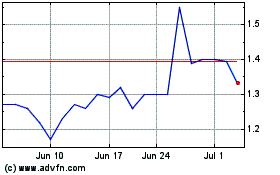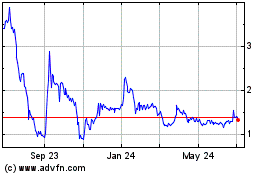Theratechnologies Inc. (“Theratechnologies” or the “Company”) (TSX:
TH) (NASDAQ: THTX), a biopharmaceutical company focused on
development and commercialization of innovative therapies, today
announced data from two poster presentations, focusing on the
association between excess visceral abdominal fat (EVAF) and
cardiovascular disease (CVD) risk in people with HIV (PWH), and on
the use of tesamorelin to reduce such risk.
In a poster presentation at IDWeek 2024 in Los
Angeles, Calif., investigators from the Visceral Adiposity
Measurement and Observations Study (VAMOS) reported that EVAF is
one of several risk factors that contribute to heightened CVD risk
in PWH who are on modern anti-retroviral therapy (ART) regimens. In
a separate poster presentation, researchers demonstrated that the
EVAF-lowering properties of tesamorelin, a growth hormone-releasing
factor (GHRF), enable a reduction in CVD risk in PWH.
“The two studies presented at IDWeek 2024
suggest that excess visceral abdominal fat is an overlooked risk
factor for cardiovascular disease in people with HIV, and that use
of tesamorelin for visceral abdominal fat reduction may contribute
to lowering cardiovascular disease risk,” said Christian Marsolais,
Ph.D., Senior Vice President and Chief Medical Officer of
Theratechnologies. “We hope greater awareness of EVAF, and of
strategies to address this risk factor, lead to improved outcomes
in people with HIV being treated with ART medicines.”
VAMOS Data
VAMOS, a cross-sectional, multicenter
observational study, is the first trial designed to improve the
understanding of the impact of EVAF on CVD, steatotic liver
disease, insulin resistance, and other metabolic parameters in PWH
who are on modern ART regimens. The investigators examined the
impact of EVAF (defined as visceral fat surface area ≥130 cm2 by CT
scan) on traditional CVD risk factors and overall cardiovascular
(CV) risk in 170 participants with HIV. The prevalence of EVAF in
the study was 58%, and the mean visceral fat area was 148 cm2.
Among participants with EVAF, values for the Homeostatic Model
Assessment for Insulin Resistance (HOMA-IR; p≤0.0001) and
triglyceride:high-density lipoprotein (TG:HDL) ratios (p=0.0013)
were higher than in those without EVAF. Investigators noted a
positive correlation between EVAF and HOMA-IR (ρ=0.43, p≤0.0001)
and TG:HDL ratios (ρ=0.33, p≤0.0001).
Importantly, greater EVAF was associated with a
higher 10-year atherosclerotic cardiovascular disease (ASCVD) risk
(p≤0.0001). The investigators also found that increasing visceral
fat surface area was inversely associated with growth hormone (GH)
levels (ρ=-0.17, p=0.03), and that participants with EVAF had lower
GH levels overall (p=0.05).
“Excess visceral abdominal fat, or EVAF, is the
key characteristic of central adiposity, a condition that is still
prevalent in today’s population of people living with HIV, even
among those who were never exposed to earlier anti-retroviral
agents,” commented VAMOS investigator, John Koethe M.D., Associate
Professor of Medicine at Vanderbilt University. “As the quantity of
visceral fat rises, 10-year ASCVD risk scores increase, as well as
traditional risk factors including insulin resistance and lipid
levels. Together, these factors contribute to the heightened risk
of cardiovascular disease we see in people with HIV, which is a
particular concern among aging individuals. Additionally, the
relationship we observed between EVAF and decreased growth hormone
levels appears to support a focus on the growth hormone axis to
impact EVAF.”
Tesamorelin CV Risk Data
Researchers examined data from two phase 3
randomized studies to assess the impact of tesamorelin-induced
reduction of EVAF on CVD outcomes in 543 PWH. They calculated
10-year ASCVD risk scores for participants at baseline and at 26
weeks of tesamorelin treatment. The percentages of participants on
lipid-lowering therapies, antihypertensive treatment, or diabetes
medications were 44%, 37%, and 18%, respectively.
Although most participants had low CVD risk at
baseline, 44% had borderline to high CVD risk. Participants on
tesamorelin tended toward a modest reduction in 10-year ASCVD risk
scores, with an estimated change of -0.4% (95% confidence interval
[CI] -0.89%, 0.05%). The reduction in CVD risk was relatively
larger among subjects with higher CVD risk at baseline (p=0.038 for
the overall trend among all participants). These reductions in
ASCVD risk scores were driven primarily by reductions in total
cholesterol, independent of lipid-lowering therapies.
“Our analysis provides evidence that tesamorelin
may contribute to a reduction in forecasted cardiovascular disease
risk in persons with HIV, particularly among individuals at the
highest baseline risk,” stated investigator Lindsay Fourman, M.D.,
Massachusetts General Hospital and Harvard Medical School. “Given
the high prevalence of obesity and central adiposity in this
population, a strategy that selectively reduces excess visceral
abdominal fat may be particularly effective in CVD risk
management.”
IDWeek 2024, taking place October 16-19, is the
joint annual meeting of the Infectious Diseases Society of America,
the Society for Healthcare Epidemiology of America, the HIV
Medicine Association, the Pediatric Infectious Diseases Society and
the Society of Infectious Diseases Pharmacists.
About Theratechnologies
Theratechnologies (TSX: TH) (NASDAQ: THTX) is a
biopharmaceutical company focused on the development and
commercialization of innovative therapies addressing unmet medical
needs. Further information about Theratechnologies is available on
the Company's website at www.theratech.com, on SEDAR+
at www.sedarplus.ca and on EDGAR at www.sec.gov.
Follow Theratechnologies
on Linkedin and Twitter.
Forward-Looking Information
This press release contains forward-looking
statements and forward-looking information (collectively, the
“Forward-Looking Statements”), within the meaning of applicable
securities laws, that are based on our management’s beliefs and
assumptions and on information currently available to our
management. You can identify Forward-Looking Statements by terms
such as "may", "will", "should", "could", “promising”, “would”,
"outlook", "believe", "plan", "envisage", "anticipate", "expect"
and "estimate", or the negatives of these terms, or variations of
them. The Forward-Looking Statements contained in this press
release include, but are not limited to, statements regarding the
use of tesamorelin for visceral abdominal fat reduction
contributing to lowering cardiovascular disease risk and attention
to targeting excess visceral abdominal fat when considering CVD
risk management. Forward-looking statements involve a number of
assumptions, risks and uncertainties. Some of these assumptions
include, but are not limited to, the fact that people living with
HIV taking tesamorelin for visceral abdominal fat reduction will
lower the risk of cardiovascular disease. The Company refers
current and potential investors to the “Risk Factors” section of
the Company’s Annual Information Form filed on Form 20-F dated
February 21, 2024 available on SEDAR+ at www.sedarplus.ca and on
EDGAR at www.sec.gov under Theratechnologies’ public filings for
the risks associated with the business of Theratechnologies. The
reader is cautioned to consider these and other risks and
uncertainties carefully and not to put undue reliance on
forward-looking statements. Forward-Looking Statements reflect
current expectations regarding future events and speak only as of
the date of this press release and represent the Company’s
expectations as of that date.
The Company undertakes no obligation to update
or revise the information contained in this press release, whether
as a result of new information, future events or circumstances or
otherwise, except as may be required by applicable law.
Contacts:
Media inquiries:Julie SchneidermanSenior Director,
Communications & Corporate
Affairscommunications@theratech.com1-514-336-7800
Investor Inquiries:Philippe DubucSenior Vice President and Chief
Financial Officerpdubuc@theratech.com438-315-6608
Theratechnologies (NASDAQ:THTX)
Historical Stock Chart
From Oct 2024 to Nov 2024

Theratechnologies (NASDAQ:THTX)
Historical Stock Chart
From Nov 2023 to Nov 2024
